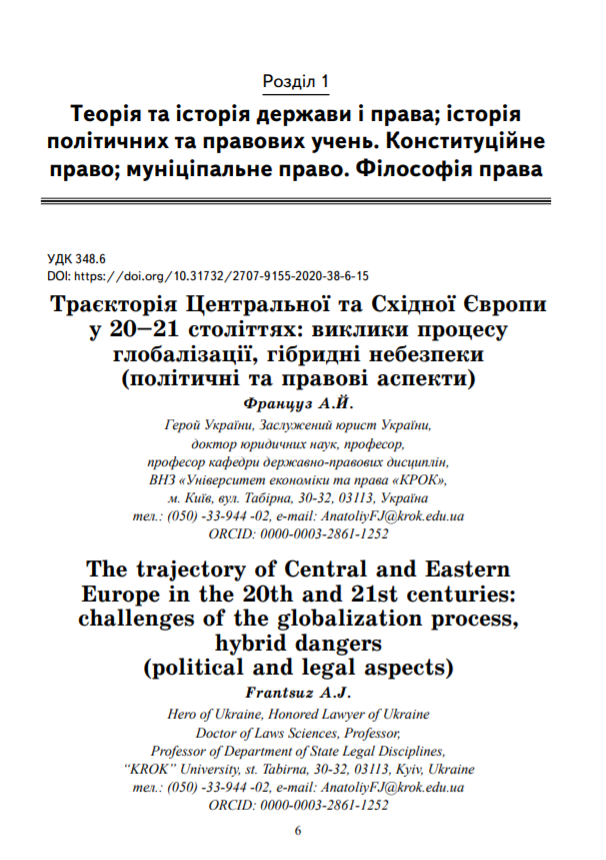The trajectory of Central and Eastern Europe in the 20th and 21st centuries: challenges of the globalization process, hybrid dangers (political and legal aspects)
Keywords:
globalization, Central and Eastern Europe, sustainable development, multipolarity, hybrid war, terrorismAbstract
Central and Eastern Europe have a special place in the new multipolar world order, shaped by the infl uence of the European Union, the United States, China, and Russia. To understand the European perspective in the rules-based international order, the geopolitical trajectory of the region and its status in international law should be discussed with regard to the whole scope of historical, political, economical, and ecological issues. The hybrid globalization process includes divisions and armed confl icts initiated for the sake of far-reaching global interests. Central and Eastern Europe today, after the Russian aggression against Ukraine, is turned into a frontline of the conflict between the global East and West. Russian militarism, predictably dangerous and insidious, in propaganda presents its thrusts as a reaction to the militarization of the region by the NATO forces. The annexation of Crimea, military invasion into Eastern Ukraine, and arms race are examples of Russian imperialist policies. Robust strategy and meaningful transformations are needed to prepare Central and Eastern Europe for future challenges and threats in a contingent geopolitical environment.
References
Вольф, Л. Відкриття Східної Європи: карта цивілізації в умах Просвітництва; Видавництво Стенфордського Університету, 1994. 287 с.
Тейлор, П.; Флінт, С. Політична географія: світова економіка, національні держави та місцевості; Прентайс Холл: Гарлоу, 2000.
Снайдер, Т. Криваві землі: Європа між Гітлером та Сталіним; Основні книги: НьюЙорк, 2012. 492 с.
Еплбаум, A. Чи існує ще Східна Європа? Перспектива, 20 березня 2013 року.
Горбулін, В. Світова гібридна війна: українська передова; Фоліо: Харків, 2017. 496 с.
Саква, Р. Назад до стінки: міфи та помилки, які знову поділяють Європу. Російська політика. 2016, 1 (1), 1–26.
Хіггінс, А. «Нова Берлінська стіна»: чому Україна є центральною у скандалі. Нью-Йорк Таймс, 27 вересня 2019 року.
Штефан Г.; Нерев В.; Траща Д.; Саліян Д.; Матак Л. «Соціальна трилема»: емпіричні дані з Центральної та Східної Європи. Стійкість. 2019, 11 (17), 4638.
Гі К.; Цао X. Прояви закономірностей та впливів у мережах прямих іноземних інвестицій між країнами в регіонах «Одного пояса, одного шляху». Стійкість. 2019, 11 (17), 4724.
Атлантична Рада. Чи повинні США озброювати Україну? Дебати [Відеофайл]. YouTube,
вересня 2017. URL: https://youtu.be/OFaI53PzfGk (дата звернення 12.02.2020)
Савранська С.; Блантон Т. Розширення НАТО: що почув Горбачов. Архів національної безпеки, 12 грудня 2017 року. URL: Https://nsarchive.gwu.edu/briefing-book/russia-programs/2017-12-12/nato-expansion-what-gorbachev-heard-western-leaders-early (датазвернення 12.02.2020)
Бергедорфський Круглий стіл. Кордони та горизонти ЄС: нові сусіди Україна, Білорусь та Молдова; Кюрбер-Штіфтунг: Гамбург, 2005.


